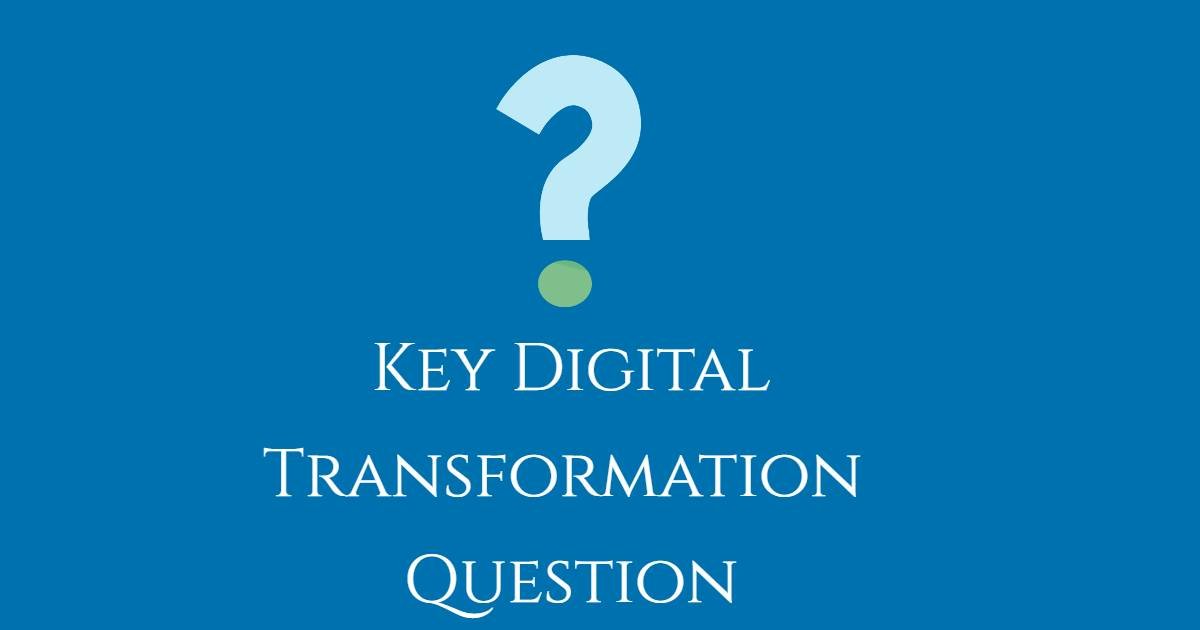How to Develop a Digital Transformation Strategy in 7 Steps
Digital transformation is no longer optional. It has become necessary for businesses to be relevant and competitive in today’s fast-paced world. But where do you start? Developing a digital transformation strategy can seem daunting, but it doesn’t have to be. This blog post will guide you through seven steps to build an effective system.
From assessing your current digital landscape to monitoring and measuring the impact, we will cover everything you need to know. We will also discuss how important leadership can be in driving digital transformation and the mistakes you should avoid. Let’s step through the process of developing a successful strategy and take your business to new heights.
Understanding Digital Transformation Strategy
In this era of technology, businesses must embrace the opportunities of a well-defined digital transformation strategy. By leveraging digital technologies, organizations can drive business growth and success, gaining a competitive edge in the market. Digital transformation unlocks new business models and revenue streams and enhances customer experience and satisfaction through digital capabilities. This strategic shift enables companies to stay ahead and adapt to the evolving digital landscape.
Digital transformation power lies in its ability lies in its ability to embrace new ways of doing business and create more opportunities, utilizing technologies such as social media, e-commerce, cloud computing, and analyzing big data. Organizations navigating this transformation successfully can lower costs, streamline workflows, and create new customer value. According to McKinsey, companies prioritizing digital transformation outperform their peers regarding revenue growth and profitability.
By understanding its essence and its impact on various aspects of business, organizations can pave the way for a successful digital journey.
The Essence of Digital Transformation
Organizations must embrace the digital transformation concept to drive business value and growth. Your business can make informed decisions and gain valuable insights by leveraging data analytics and artificial intelligence. Utilizing digital tools and technologies optimizes business processes, improving efficiency and productivity.
In the face of digital disruption, agility and flexibility are crucial to surviving and thriving. It’s not just about implementing new systems; it’s about transforming the entire business to adapt.
This means embracing new ways of thinking, collaborating, and engaging with customers. Digital transformation is about creating new capabilities, exploring new use cases, and challenging the status quo. It’s about reimagining customer service, leveraging social media and e-commerce, and capitalizing on the potential of cloud computing and application programming interfaces (APIs). Embracing the essence is how organizations can stay relevant in a rapidly changing landscape.

Step 1: Assessing the Current Digital Landscape
The first step to developing a successful digital transformation strategy is assessing the digital landscape. This involves conducting a comprehensive analysis of existing digital capabilities and evaluating the effectiveness of current digital technologies. By identifying gaps and areas for improvement in the digital landscape, organizations can determine what needs to be addressed in their transformation efforts.
Furthermore, analytics insights can enable informed decision-making throughout the entire process. Understanding the impact on the organization is crucial, including its customer service, supply chain, and overall workflow. Then, a foundation is laid for a strategic and impactful journey by assessing the digital landscape.
Evaluating Your Current Technologies
For this process to take hold, we must look within ourselves and our operations, as It is essential to evaluate your current technologies. Assess the fit of your existing systems with your digital goals and determine if they can support the desired outcomes. Also, assess your current technologies’ scalability and integration capabilities, considering their potential for automation and digitization in business processes. Embracing emerging technologies like IoT and cloud computing can give you a competitive advantage.
By exploring the use of these technologies and understanding their potential, you can unlock new capabilities and find new ways to deliver value to your customers. Consider insights from industry leaders like McKinsey, Gartner, and Harvard Business Review to stay updated on digital transformation trends and best practices. Evaluating your current technologies allows for identifying gaps and opportunities for improvement, ensuring that your digital transformation strategy has a solid foundation.
Step 2: Identifying Digital Goals and Objectives
Establishing specific and quantifiable objectives for your company that align with your general business plan is essential to maintaining a unified strategy. Developing key performance indicators (KPIs) is crucial to keep track of your progress and assess the efficiency of your digital undertakings.
It would be best to decide what goals your organization wants to achieve and ensure those goals are consistent with your overall business strategy. Setting performance indicators is necessary to track progress and see if your digital initiatives are working. Identifying opportunities for digital transformation in various business areas is essential, ensuring that your goals align with customer needs and expectations.
By doing so, you can leverage the power of digital technologies to drive innovation, improve customer experience, and achieve new levels of efficiency.
Defining Success in Your Digital Journey
Measuring success goes beyond just tracking which metric works for a given situation. It involves quantifying tangible business outcomes that result from your digital transformation strategy. One way to gauge success is by monitoring customer satisfaction and loyalty, which are strong indicators of your digital initiatives’ impact on your target audience. Additionally, it’s essential to evaluate its effect on revenue and profitability.
Analyzing financial data lets you determine if your digital efforts drive growth and improve the bottom line. Another crucial aspect of success is prioritizing user experience (UX). Providing a seamless and intuitive digital experience enhances customer satisfaction and increases the chances of achieving desired outcomes. Continuously refine your goals and strategies based on feedback and insights gained throughout your journey to ensure sustained success.

Step 3: Designing the Digital Transformation Strategy Framework (Roadmap)
You must follow specific steps to develop an excellent digital transformation plan for your business. Designing a digital transformation framework is the first step, which involves defining the guiding pillars and components. It would help if you also established governance and change management processes to ensure that the framework works effectively.
It is essential to identify the resources and capabilities required for digital transformation. These include expertise in digital marketing and customer service. Furthermore, ensuring alignment with organizational goals to achieve maximum benefits is necessary. By incorporating Natural language processing (NLP) terms like cloud computing, big data, and the internet, businesses can leverage digital systems and explore new ways to create value.
The use of APIs and workflow automation can optimize processes and lower costs. To successfully drive digital transformation, staying informed about industry trends and insights from strategic partners is essential. Following these steps and considering the mentioned factors allows businesses to design a robust digital transformation framework that sets them up for success.
Core Elements of an Effective Framework
Incorporating core elements in the framework is crucial. One key factor is fostering collaboration and communication across departments and teams. This ensures that everyone is aligned towards the common goals of digital transformation.
Embracing experimentation and a culture of continuous improvement is another essential element. This allows for exploring new ideas and technologies, enabling organizations to stay ahead of the curve.
Aligning the framework with emerging digital technologies and trends is vital to ensure relevance and competitiveness in the digital landscape. Incorporating scalability and flexibility allows the framework to adapt to evolving needs and changing market dynamics.
It would help if you also considered the impact of digital transformation on the organization’s operating model, which is crucial for successful implementation. Organizations can develop a practical framework to navigate the digital landscape and unlock new value by addressing these core elements.
Step 4: Organizational Culture and Digital Transformation
Organizations must cultivate a culture of innovation and embrace a digital mindset to navigate the digital transformation journey successfully. This involves fostering employee engagement and buy-in for digital initiatives, encouraging collaboration and knowledge sharing across departments, and providing training and resources to enhance digital capabilities. Organizations can motivate employees to actively participate in the transformation process by rewarding and recognizing digital achievements.
Incorporating these strategies creates an environment that supports and nurtures the adoption of digital systems and new ways of working. According to McKinsey, organizations prioritizing culture and employee engagement are more likely to achieve successful digital transformations. By embracing an organizational culture that values digital innovation, companies can break free from the status quo and develop new capabilities that drive growth and sustainability.
Fostering a Culture of Innovation
Promoting curiosity and creativity is essential to fostering an innovative culture in today’s ever-evolving digital landscape. Encourage your team to explore the digital opportunities available to them, which can spark new ideas and lead to breakthrough solutions. Creating a safe environment for learning from failures can also pave the way for risk-taking and more innovative problem-solving.
Emphasizing the value of adapting to change and embracing new technologies is another crucial component of driving organizational innovation. With rapid technological advancements, businesses must stay current and relevant by adopting new tools and strategies that align with their goals.
Recognizing innovative ideas and solutions motivates employees to contribute their best work. Celebrate successes as they happen, no matter how small, as this can create a positive feedback loop that encourages further innovation.
Finally, involving employees in digital transformation can help build a more creative and forward-thinking organization. By giving them a voice in shaping the future of the business, they are more likely to feel invested in its success and be motivated to contribute their best work. Building a culture of curiosity, creativity, and innovation is crucial for businesses looking to thrive in the current era of technology and digital advancements.

Step 5: Implementing the Digital Transformation Strategy
Implementing the digital transformation strategy requires breaking the overall plan into smaller, achievable tasks. By doing this, you can ensure that each job has clear ownership and responsibilities. Developing a detailed implementation plan with timelines and milestones is essential to track progress effectively. Communication is vital in this step, as you need to align all stakeholders with the strategy. This is a critical implementation function.
Regularly monitoring progress allows you to make necessary adjustments along the way. This ensures that the implementation stays on track and meets the desired goals. Following these steps, you can successfully implement your strategy and drive your organization towards new capabilities and competitive advantage.
Overcoming Challenges in Implementation
Anticipating resistance to change and developing strategies to address it is vital. Providing adequate training and support to employees during the implementation phase helps them adapt to the new digital systems and processes. Ensuring the resources are available to execute the strategy effectively is also essential.
Fostering a culture of collaboration and innovation within the organization encourages employees to embrace the changes and overcome implementation challenges more effectively. Continuous communication about the benefits and progress of the transformation keeps the momentum going and helps stakeholders understand the value of the strategy. By addressing these challenges head-on, organizations can navigate the implementation phase smoothly and achieve successful digital transformation.
Step 6: Monitoring and Measuring the Impact with Analytics
Observing and assessing its impact is imperative to guarantee the triumph of your digital transformation plan. Determining key performance indicators (KPIs) that correspond with your transformation objectives would be best. Use analytics and data science to track and scrutinize the consequences of your strategy, enabling you to obtain valuable insights into its efficacy.
Frequently examine and appraise the metrics to pinpoint areas for enhancement and make informed judgments based on real-time data. By implementing the knowledge acquired from the monitoring process, you can refine and optimize your plan, ensuring that it persists to advance and fulfill the evolving requirements of your company. Monitoring and gauging the impact of your digital transformation strategy will empower you to drive continuous improvement and accomplish long-term success.
What Metrics Matter Most in Digital Transformation?
Metrics that matter most in digital transformation include customer experience metrics like satisfaction and retention rates, financial metrics such as revenue growth and cost savings, operational metrics like enhanced efficiency and increased productivity, employee engagement and satisfaction metrics, and adoption and usage metrics for digital tools.
Step 7: Adapting and Evolving Your Strategy
To ensure your digital transformation strategy is successful, continuously evaluating the business landscape and market trends is vital. Keeping up to date with emerging technologies and best practices in the industry is crucial to stay competitive. Gathering feedback from employees, customers, and stakeholders will help pinpoint areas for improvement and make necessary adjustments.
Embracing experimentation and fostering a culture of innovation is vital in driving evolution in your strategy. Regularly reviewing and updating your system will help you stay relevant and competitive in the fast-paced digital world. By keeping your plan agile and flexible, you can adapt to new challenges and opportunities that arise.
Keeping Your Digital Strategy Agile and Flexible
To keep your digital strategy agile and flexible, it is essential to embrace an agile methodology for project execution and decision-making. This approach allows for quick adaptation to changing circumstances and informed decisions based on real-time data. Furthermore, fostering a culture of adaptability and learning from failures is crucial. Encouraging cross-functional collaboration and knowledge sharing promotes innovation and ensures that different perspectives are considered.
Leveraging digital technologies like IoT and cloud computing allows for faster and more seamless organizational changes. Regularly reevaluating and reprioritizing initiatives based on business needs and market dynamics ensures that your strategy remains aligned with your goals and objectives. By using these strategies, staying ahead in the digital transformation journey is much easier, and you can achieve sustainable growth.
How Important is Leadership in Driving Digital Transformation?
Leadership is crucial in driving digital transformation by setting the vision, championing change, providing resources, and fostering innovation. They must lead by example and embrace digital technologies to inspire the organization.
Role of Leadership in Successful Digital Transformation
Leadership plays a pivotal role in driving successful digital transformation. To ensure a seamless transition, leaders should create a sense of urgency and mobilize the entire organization for change. They should establish a clear and compelling vision that aligns with the organization’s goals and objectives. By empowering and motivating employees, leaders can encourage them to embrace digital initiatives and drive innovation.
Removing barriers and promoting alignment across different departments is essential to ensure a smooth implementation process. Effective communication of progress and the benefits of digital transformation is crucial in keeping employees engaged and motivated. As leaders navigate the complexities of digital transformation, their guidance and support are vital to achieving sustainable growth and competitiveness.
What Mistakes Should You Avoid in Your Digital Transformation Journey?
Common mistakes to avoid in your digital transformation journey include not defining a clear vision, neglecting employee involvement, overlooking change management, lacking digital capabilities/resources, and ignoring the need for continuous monitoring and adaptation.

What is an example of a digital transformation strategy?
An example of a digital transformation strategy is implementing cloud-based technology to streamline operations and increase efficiency. Another example is adopting artificial intelligence or machine learning to automate tasks and improve decision-making.
Developing a mobile app or website to enhance customer experience can also be part of a digital transformation strategy. A successful strategy aligns with business goals and integrates technology across all departments.
Final Thoughts
Developing a digital transformation strategy requires careful planning and execution. Using the seven steps above, you can create a roadmap for success and ensure your organization stays ahead in this rapidly evolving digital landscape. Remember to regularly monitor and measure the impact of your strategy, and be prepared to adapt and evolve as needed.
Leadership plays a crucial role in driving transformation, so make sure to have strong leaders who are committed to the process. Lastly, be aware of the common mistakes to avoid. Check out our blog for other ideas on enhancing your digital transformation journey.
